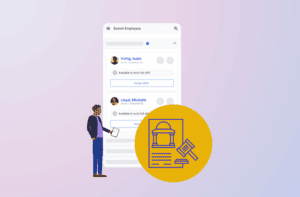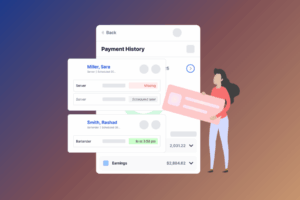Share
How you can stay up to date on compliance in the U.S.
When you’re managing an hourly team, processing payroll, and tracking benefits, all while keeping up with laws that seem to change overnight, compliance can feel like one more thing waiting to go wrong. And if your HR team is lean, it can be challenging to manage so many compliance details.
But here’s the good news: With the right processes (and the right tools), staying compliant doesn’t have to mean staying overwhelmed. In fact, it can be an opportunity to streamline your operations, strengthen employee trust, and sleep a little easier at night.
Let’s break down where compliance and payroll come together and how HR teams like yours can stay ahead without burning out or making common mistakes.
It’s not just about avoiding penalties (although, yes, those can be steep.) Today’s workforce expects transparency and consistency, especially when it comes to things like benefits, retirement contributions, and paid leave.
Why Compliance Matters More Than Ever
And on the backend? Every one of those programs depends on accurate payroll data. If benefits are out of sync with deductions, or retirement contributions aren’t being tracked correctly, the result isn’t just a paper trail nightmare. It’s a people problem, too.
A misstep in one area (say, an incorrect FSA deduction) can trigger issues across W-2s, ACA filings, and even employee morale. Get it right, and your HR function becomes a source of stability and confidence. Get it wrong, and the ripple effects are felt for months. There’s also a time factor. CIPP suggests that one single data point mistake or input error can waste as much as 20% of an employee’s time.
Did you know: The IRS reports that approximately 33% of employers still make payroll errors that result in significant costs annually. And 40% of small to mid-sized businesses average $845 in incorrect payroll filings alone.
Where Payroll and Compliance Overlap
While most HR professionals know they’re responsible for compliance, not everyone realizes just how much of it flows through payroll. Below are the most common benefit and compliance areas directly tied to your payroll system:
- Workers’ Compensation
- Retirement Plans (401(k), Roth, etc.)
- Health Insurance and ACA Tracking
- Pre-Tax Benefits (FSA, HSA, commuter)
- COBRA Administration
- Leave and Disability Policies (FMLA, PFML, state DI)
Each of these programs carries unique regulatory responsibilities, and they all rely on precise payroll inputs like wages, hours, classifications, and eligibility.
Workers’ Comp: The Hidden Payroll Risk
Workers’ compensation insurance, as you know, is mandatory in nearly every state. But how much you pay and whether you’re compliant depends entirely on your payroll accuracy. That’s because workers’ comp premiums are calculated based on your employees’ job classifications and wage data. Get the classification codes wrong or report wages inconsistently, and you could either overpay by thousands… or open yourself up to an audit.
Compliance Checklist:
- Classify employees using up-to-date job codes
- Track wages in real-time for accurate premium estimates
- Exclude non-taxable wages if your policy requires it
- Confirm your reporting frequency with your carrier (monthly, quarterly, audit-based)
Pro Tip: Automating job classifications and wage reporting can eliminate overpayment risks and give you cleaner records at audit time.
401(k) Compliance: It’s About Timing and Precision
401(k) compliance is governed by ERISA, IRS contribution limits, and Department of Labor rules, which is another way of saying that there’s a lot to get wrong.
From tracking eligibility to calculating employer matches and enforcing contribution caps, your payroll system has to be dialed in and synced in real-time. The most common mistake? Delays in remitting employee contributions are something the DOL flags quickly.
Top Payroll Priorities:
- Withhold and remit employee contributions within 3–5 business days
- Track both pre-tax and Roth contributions accurately
- Adjust deductions immediately when employees change elections
- Ensure match percentages follow your plan’s rules
Common Pitfalls:
- Forgetting to exclude certain bonuses from eligibility
- Missing contribution cap alerts
- Running NDT testing without accurate compensation data
The fix? Integrate your payroll system directly with your retirement plan provider or TPA. That way, hourly employee deferrals, and employer matches stay aligned without you having to chase spreadsheets.
Health Benefits: ACA, Section 125 & Real-Time Accuracy
Health insurance compliance has grown increasingly complex, especially for businesses categorized as Applicable Large Employers (ALEs) under the ACA. But even smaller teams aren’t off the hook when it comes to proper deductions, Section 125 compliance, and COBRA administration.
Here’s where the payroll data plays a starring role:
- ACA Reporting: Form 1095-C codes depend on accurate offer-of-coverage and affordability tracking
- Pre-Tax Deductions: Must follow IRS Section 125 guidelines and be applied consistently
- Qualifying Life Events: Mid-year changes (marriage, birth, loss of coverage) need to be handled promptly and accurately
- COBRA: You need to track events, issue notices, and collect premiums on time
What HR teams often miss: The moment an employee has a life event, that change must flow through payroll immediately. Miss a deduction update or delay a COBRA notice, and you risk compliance fines or, worse, an employee losing coverage.
Leave & Disability: More Than Just Time Off
Between FMLA, PFML, and state-mandated disability insurance, leave laws are among the fastest-changing areas of compliance, and they’re deeply tied to wage history and job classification.
Where Payroll Steps In:
- Paid leave eligibility often hinges on average hours worked or wages earned
- Disability and PFML benefits are calculated based on past payroll data
- Deductions for state programs (like CA SDI or NY PFL) must be applied accurately on each pay cycle
HR teams need visibility into who’s taking leave, how long, and whether deductions or accruals should pause or continue. A misstep can result in inaccurate benefit payments or noncompliance with wage replacement laws.
Smart Move: Use a platform that tracks leave status alongside payroll, so there’s no disconnect between time off and compensation.
Recordkeeping: The Compliance Safety Net
You can do everything right… but if your records aren’t organized, audit season gets ugly fast.
Between ERISA, the DOL, and the IRS, you’re required to retain payroll and benefit records for several years, including documentation of deductions, contributions, elections, and communications. If they’re stored across different platforms (or worse, buried in emails), you’re setting yourself up for stress later.
Must-Haves:
- Payroll records that show benefit deductions and earnings
- Forms and documentation related to enrollment, changes, and notices
- W-2 data with accurate benefit reporting (Box 12 codes, imputed income)
- Clear logs of contribution remittances and eligibility tracking
The solution is simple: centralize your data. When payroll, benefits, and reporting live in the same system, pulling audit-ready reports becomes a 5-minute task, not a 5-week panic.
What Netchex Brings to the Table
Compliance doesn’t have to be complicated, especially when your tools are working together.
At Netchex, we’ve built a single, easy-to-use platform that connects payroll, benefits, time, and compliance alerts in real-time. No more rekeying data. No more disconnected systems. Just confidence that everything is in sync.
Why HR teams choose Netchex:
- Payroll and benefits data in one place
- Real-time alerts for remittance deadlines and deduction caps
- Seamless 401(k), COBRA, and ACA reporting tools
- U.S.-based support that actually shows up
In short? We take compliance seriously, so you don’t have to stress about it.
Stay Ahead, Not Stuck
Compliance doesn’t have to be something you chase. When you build your strategy around accurate payroll, smart tools, and proactive tracking, staying compliant becomes part of your everyday workflow and not a last-minute scramble.
- Build a compliance calendar.
- Run regular audits.
- Use tools that simplify, not complicate, your day.
And when you’re ready to stop managing compliance manually?
We’re here to help.
Talk to our team today, and let’s take the stress out of compliance—together.
Related articles

SECURE 2.0 Act: What Business Leaders Need to Know

It’s Time for Your Year-End Audit: 7 Mistakes to Avoid

What Makes Netchex Different from Other Payroll Platforms?

